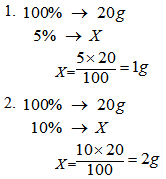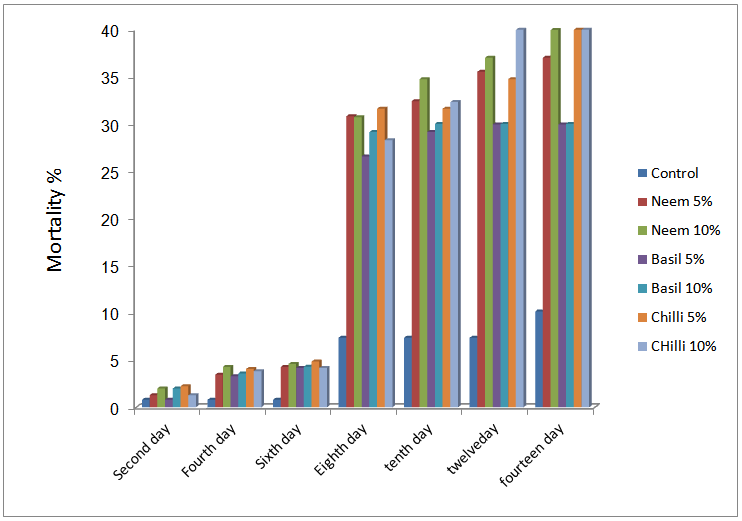-
Paper Information
- Next Paper
- Paper Submission
-
Journal Information
- About This Journal
- Editorial Board
- Current Issue
- Archive
- Author Guidelines
- Contact Us
International Journal of Agriculture and Forestry
p-ISSN: 2165-882X e-ISSN: 2165-8846
2014; 4(6): 415-418
doi:10.5923/j.ijaf.20140406.01
Effects of Neem, Basil and Chilli Powders on the Mortality of the 3rd Larval Instar of the Red Flour Beetle Tribolium castaneum (Herbst) (Coleoptera: Tenebrionidae)
Mohammed Esmail Abdalla Elzaki1, Abdalla Mohamed Ali2
1Nanjing Agricultural University, College of Plant Protection, department of Entomology, Nanjing, China
2Department of crop protection, Faculty of Agriculture, University of Khartoum, Khartoum, Sudan
Correspondence to: Mohammed Esmail Abdalla Elzaki, Nanjing Agricultural University, College of Plant Protection, department of Entomology, Nanjing, China.
| Email: |  |
Copyright © 2014 Scientific & Academic Publishing. All Rights Reserved.
This study was carried out in the Laboratory of the Department of Crop Protection, Faculty of Agriculture, University of Khartoum, Shambat, Sudan. During December 2010. The objectives of this study was to evaluate the effect of neem leaves, basil leaves and chilli fruits powder against: the 3rd larval instar of Red flour beetle Tribolium castaneum (Herbst) (Coleoptera: Tenebrionidae). Larvae mortality was used as parameter of efficacy. The local sorghum seeds variety (Fatarita) was used as food in this study. Each 20 gms of clipped sorghum grains were placed into a Petridish. Each pertidish was treated with the powder of each product separately at two concentrations of 5% and 10% (w/w). Twenty larvae of T. castaneum were placed in each treated Petridish. Each treatment was replicated four times. Four replicates were left as control. The count was done every 48 hrs for two weeks. The results showed that all the treatments caused mortality of the 3rd larval instar of T. castaneum as compared to the control. There were significant differences between treatments and control. Both neem and chilli at the concentration of 5% and 10% were better than basil concentrations. There were no significant differences between neem and chilli.
Keywords: T. Castaneum,Neem, Basil, Chilli powders
Cite this paper: Mohammed Esmail Abdalla Elzaki, Abdalla Mohamed Ali, Effects of Neem, Basil and Chilli Powders on the Mortality of the 3rd Larval Instar of the Red Flour Beetle Tribolium castaneum (Herbst) (Coleoptera: Tenebrionidae), International Journal of Agriculture and Forestry, Vol. 4 No. 6, 2014, pp. 415-418. doi: 10.5923/j.ijaf.20140406.01.
Article Outline
1. Introduction
- Insects are one of the most serious and hazardous pests to stored grains all over the world. Insect pests inflict their damage on stored products mainly by direct feeding and through contamination by insect parts. During storage high losses occur. FAO estimated the annual losses in storage grain due to insects as amounting to 13 million tons. Different species of insects are responsible for yield reduction of grains, beetles and moths are the predominant ones [1].Several species of Tribolium are economically important pests and can be found in almost every store containing infested cereals or cereal products, especially in tropical and sub-tropical climates. T. castaneum is a very common and serious pest which attacks maize, wheat, flour and other foodstuffs, in tropical climates [2].Around the world, residual chemical insecticides and fumigation are the major of choice for the control of stored-product insects [3]. Their widespread use has led to some serious problems, including development of insect strains resistant to insecticides, toxic residues on stored grain, and health hazards to grain handlers [4]. These problems led to the scientific search for safer alternatives. Many possible sources of safe alternatives were explored and subject to intensive studies. Naturally occurring products of plant origin are among the promising botanical substitutes of conventional pesticides which are characterized by low mammalian toxicity, relatively short environmental persistence and enhanced selectivity to target pests. Scientists in different parts of the world are working for the development and establishment of plant based pesticide, usually called as phytopesticide, botanical pesticide, biopesticide or natural pesticides [5]. Over the past years, interest in botanical insecticides has increased as a result of environmental concerns and insect populations becoming resistant to conventional chemicals. Botanical insecticides are naturally occurring insecticides that are derived from plants [6].The specific objectives of this study were to: study of Neem leaves, Basil leaves and Chilli fruits as powders on the mortality of the 3rd larval instar of the Red flour beetle Tribolium castaneum (Herbst) on sorghum grain.
2. Materials and Methods
- A laboratory experiment was conducted at Shambat, Department of crop protection, Faculty of Agriculture, University of Khartoum to evaluate the efficacy of three different botanical products, Neem Azadirachta indica (Juss.), Basil Ocimum basilcum and Chilli Capsicum furtescens powder against the Red flour beetle Tribolium castaneum (Herbst).
2.1. Insect Culture
- Adults of Red flour beetle Tribolium castaneum (Herbst) were sieved from the laboratory culture of the Department of Crop protection, University of Khartoum. The adult insects were reared in plastic bucket (5 kg capacity) half filled with natural diet, local sorghum variety (Fatarita), and covered with muslin cloth fixed with rubber band and kept in the laboratory at room temperature. Adults of Red flour beetle were allowed to lay their eggs on crushed sorghum brought from local market in Omdurman. Larvae of third instars were collected from the culture for the bioassay.
2.2. Preparation of Botanical Extracts
2.2.1. Preparation of Neem and Basil Leaves Powder
- Fresh green leaves of neem and basil were randomly collected from the Faculty of Agriculture, University of Khartoum, Shambat. The leaves were washed with water and left under shade to dry for a week. The dry green leaves were then finely powdered by pestle and mourtar and kept in glass jar in the laboratory at room temperature for bioassay.
2.2.2. Preparation of Chilli Fruits Powder
- Fruits of chilli plant were obtained from Khartoum North market. The leaves were ground by electric blender; the powder was stored in glass bottle tightly covered, kept in laboratory at room temperature and used for bioassay.
2.3. Bioassy of the Plant Powder against 3rd Larval Instar
- Seeds of local sorghum variety Fatarita purchased from the local market, the seeds were soaked in water for one hour and clipped slightly by nail clipper. Twenty gms of clipped seeds were taken in a petridish (9cm in diameter). Seeds were then treated by 1g and 2g of Neem, Basil leaves and chilli powders to obtain the concentrations of 5% and 10% (w/w) respectively.
 Twenty third instar larvae were introduced in each petridish. The dead larvae were counted every 48 hrs for two weeks. The experiment was kept in the laboratory at room temperature. The experiment was arranged in completely randomized design with four replicates. The control was kept untreated.
Twenty third instar larvae were introduced in each petridish. The dead larvae were counted every 48 hrs for two weeks. The experiment was kept in the laboratory at room temperature. The experiment was arranged in completely randomized design with four replicates. The control was kept untreated.2.4. Statistical Analysis
- The data were analyzed by using analysis of variance. Means were compared by using the Least Significant Difference (LSD) method. For computation SAS software package (2004) was used.
3. Results
3.1. The Mortality Effect
- Table (1) showed that the three treatments were effective in the mortality of the 3rd larval instar of the Tribolium castaneum as compared to the control and the neem 5% and 10%, chilli 5% and 10% were more efficient than basil 5% and 10% Fig. (1).
|
 | Figure 1. Mean percentage mortality of 3rd larval instar of Tribolium castaneum after treatment with neem, chilli and basil powders |
4. Discussion
- The search for safe naturally occurring pesticides for field crops and storage pests has been intensified. There is a continuous search for natural products that can reduce insect pest population in a manner that is less hazardous. The most promising are those derived from plants. A number of investigations identified and screened a variety of promising chemical compounds from leaves and seeds of many botanical families as insect feeding deterrents and growth inhibitors [7, 8]. The present study was carried out to investigate the insecticidal effect of three plants naturally grown in Sudan namely neem, basil and chilli plants against the 3th larval instar of Tribolium castaneum Herbst. The results obtained indicated that the powders of neem, basil and chilli has some potential in the control of Tribolium castaneum Herbst.The motality caused by neem and chilli was relatively higher compared to basil. This result of neem agreed with [8] who mentioned that both neem seeds and leaves had toxic effect against Coleopterous insects. It is also agreed with [9] who showed promising insecticidal activity of neem seed powder against the larval instar of Trogoderma granarium. The obtained effects of basil agreed with Parugrug and [10] who reported low mortality of adult maize weevils from corn grains treated with O. basilicum (0.66%) after 24 days.
 Abstract
Abstract Reference
Reference Full-Text PDF
Full-Text PDF Full-text HTML
Full-text HTML